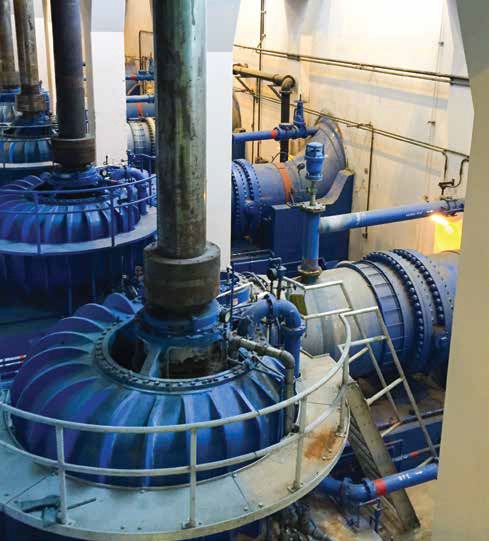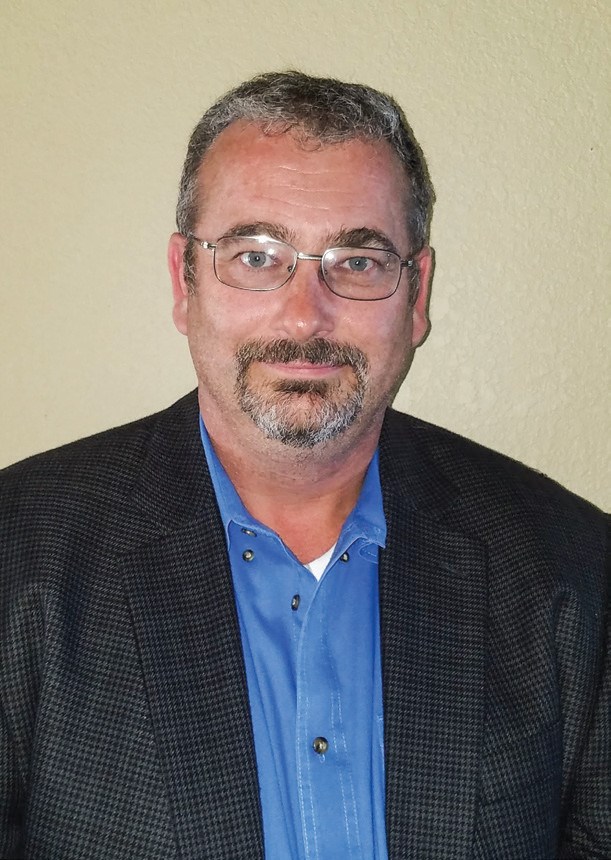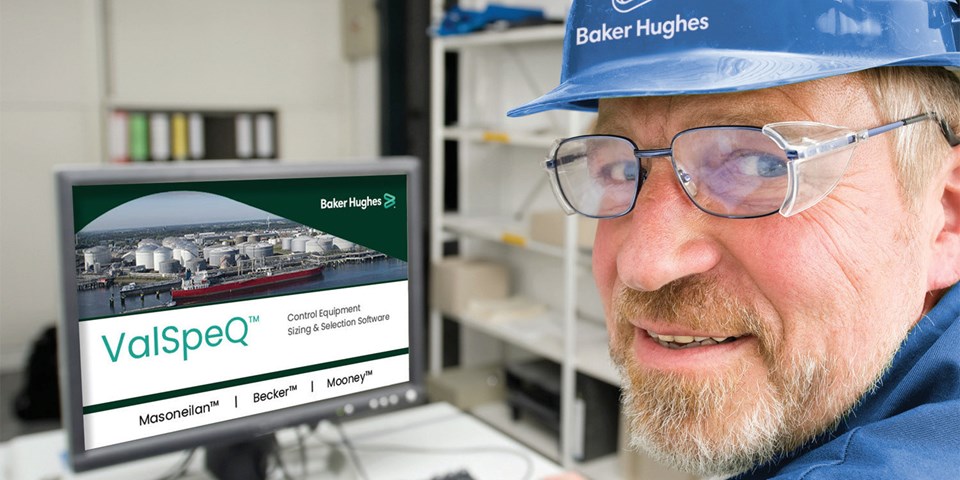By Brittani Schroeder and Sarah Bradley
Baker Hughes is the world’s first and only Fullsteam provider of integrated oilfield products, services and digital solutions. The Baker Hughes valves business has been operating since 1879 and recently celebrated its 140th anniversary. From the very first pressure relief valves created and supplied in 1879, to their newest innovation – Valve Lifecycle Management (VLM) suite – the company continually invests in new opportunities and technologies to remain a leader in the valve market. With 11 valve manufacturing facilities across the globe that allow for in-region support and quicker delivery times, Baker Hughes supports a digital valve portfolio that helps customers best manage their assets.
Nathan Brunell and Taric Kabir combined have over 40 years of experience in the valve business. “Our portfolio is centered around Masoneilan control valves and Consolidated pressure relief valve brands,” said Brunell. “These products each have over 100 years of experience, but today our focus is to expand the product value by adding digital advantages to both product lines.”
The business has a long history of innovation, dating back to significant test lab achievements such as the Masoneilan founding of the term ‘CV’ in the 1940’s, which is still the modern standard unit of measure for control valve capacity used globally. “We are constantly innovating, and a large part of that innovation is digital technology, which we have been developing over the last two decades,” explained Kabir. “The industry went through a lot of changes 70 to 80 years ago, and our brands were there through all the calculations, design methods, and innovations. Today we are still a big part of shaping industry changes.”

Diversity for the Customer
The main industry Baker Hughes serves is oil and gas. “Our valve business is very heavily involved in the downstream and gas sector. We branch off from there into LNG and pipelines, traditional power, nuclear power, offshore, process control work, and the food, beverage, and pharmaceutical industries,” said Brunell.
The company has established diverse product offerings so in the case of any downturns, they are equipped to do business with other industry segments to help weather and withstand the storm. “It is also very important to have cross pollination of our technology between product offerings,” Kabir admitted. “Baker Hughes has a broad portfolio of equipment including compressors, turbines, and drilling equipment. As we move forward, we want to take the technologies surrounding these products, and advance our valve performance using advanced data analytic technologies.” All their newest ventures and investments are in effort to give the customer the best solution possible.
Changing with the Times
Both Brunell and Kabir stress the importance of constantly striving to innovate, adapt to changing technologies and make proactive efforts to recognize where the industry is heading. “If you do not stay relevant and follow the changes that are happening, you will get left behind,” said Brunell. “It is hard to claw back and be recognized in our industry if you fall behind. So, try to lead as the first, but if you cannot you must stay current and ahead of the market as a fast follower.”
Kabir expanded on Brunell’s point by mentioning that all technology needs to stay relevant. He said, “If you are not helping to drive the next new wave of technology, it means that you are not helping the customers solve their newest problems – because that is really why new technology is invented. I think of technology as an enabler, and it helps our customers become more efficient and productive. You are not really fully engaged if you, as a company, are not helping your customers achieve that.”

An Investment in Research
Right now, the company continues to investigate new technological strategies and stresses the importance of innovating and developing new technology for the valve market. “We are trying to differentiate from what we have done in the past. There is a need for technology experts in the valve industry that continue to innovate for valve needs,” said Brunell. The company is always looking for emerging technologies for total loop process controls, early anomaly detection, and advanced additive manufacturing. He continued, “If we blend our traditional focus on product development with emerging technologies, the emerging technologies are going to seem somewhat underwhelming because they take so long to develop. We focus discrete initiatives and teams to carve out these technologies and go deep in understanding. You may not have a fast return in all areas, but once it is finished it will all be worth it by leaping the current state.”
The VLM Suite
Before the launch of the Valve Lifecycle Management (VLM) suite, Baker Hughes was developing individualized solutions for various issues. “We developed some really good solutions, but when Taric [Kabir] brought about the VLM suite, we could finally bring all those solutions together. We were not selling them as one-off products anymore; we were selling a whole solution,” explained Brunell.
The VLM suite was born out of a need to help customers manage the thousands of valve assets in their plants. “There have been a lot of different tools and technologies to try and address this need, but to this day there are not a lot of connections between valve repair history and current condition-based monitoring,” said Kabir. “With our VLM suite, we are looking at the product portfolio holistically—looking at the entire lifecycle.” Looking at the entire lifecycle could include how the valve was designed; how has the valve performed in the past, including its maintenance history and performance trends; how is the valve operating today; what is the environment that the valve is operating in. All these factors could help predict future asset health.
With VLM, Baker Hughes can tell their customers when a valve has a high likelihood of failure before it actually has an impact on the process. “One major differentiation from us and our competitors is that we are brand agnostic. Though we are a valve manufacturer and have a very proud history, our technologies focus on being able to support all of the different brands that our customers have in their install base,” Kabir explained. “If we only focus on our own valves, we are only solving a portion of the customer’s pain.”
Baker Hughes uses the terms “open” and “neutral” to describe their platform. “We will address the valve concerns not only with our valves, but also with other brands, to make sure we solve all the customer’s problems. Our tools are designed with the capability to run the same diagnostic evaluation on all valves,” said Brunell.
One of the benefits of the VLM suite is that customers do not have to worry about changing all their products to a Baker Hughes brand. Kabir said, “What we want to focus on is improving their production and efficiency, while reducing their overhead costs. We will not be able to do that quickly if we rely on revamping their entire infrastructure.”
Brunell added, “In an ideal world, we walk into a customer’s plant and they are using only our equipment. It is very different when you walk into a plant that is full of different brands, where some have been upgraded and others have not. If an EPC bought this piece of equipment, and an end user bought that, there may be no consistency. If we only offer to maximize a small share of their valves, we will not satisfy what the customer actually wants.”

Full Solutions Provider
The valve industry can be seen as very transactional: a customer wants a valve and a manufacturer sells them a valve. A few years later that customer wants a digital positioner because they want to run diagnostics, and the manufacturer sells them another product to provide that service. Later, the same customer wants to be able to understand the diagnostics, so the manufacturer sells them an analytic tool that is associated with that process.
“What we found is that customers are not getting enough strategic support from companies just selling them the product they are asking for,” said Kabir. “We see customers looking for a turnkey solution to help manage all the assets in their plants. More often we are seeing plants operated by fewer people, therefore fewer people must be able to handle critical processes and generate the most profits.
We want to help them do that.” How do they help? By giving customers more information, not just a product. Baker Hughes wants to assist their customers in managing their valve fleet, not by giving them another graph or piece of software, but by giving them actionable information that leads to solutions. “This is a root cause, this is how you solve it, now let’s plan the timing of the service”, explained Kabir.
Kabir continued, “We help define what the set of services customers need to deploy at their site to improve the overall health of their 5,000+ valves. Software and data are only good if operators can actualize it, to conduct real-world change.”
Nurturing Relationships
Covering all major industrial areas of the globe, including Singapore, Italy, USA, Africa, Mexico and the Middle East, among others, Baker Hughes is a world-recognized brand of valve equipment. By establishing qualified local partners all around the globe, they do not have to worry about customers encountering language barriers or loss of product quality. “We have service centers everywhere because there is an end user needing our services everywhere,” said Brunell. “We utilize third-party authorized, certified and trained channel partners to do field service work. This is only a good model if you can have really tight controls and a reproducible process, and you can invest in a lot of training.”
Baker Hughes has two types of channel partners. For the Consolidated brand, there is a group called GTC, which is Green Tag Centers. When a GTC introduces a pressure relief valve and asset management plan, customers recognize it as a common process that all Baker Hughes’ partners use partners use. For the Masoneilan side of the business, there is a group called MARC (Masoneilan Authorized Repair Centers). It is a similar process to GTC, but with the addition of advanced control and diagnostics as a control valve solution. Baker Hughes continues to invest in their training centers, making software and analysis a core competency for all experienced technicians around the world.
The company is also introducing a new concept called the ‘digital technician’. “This is a technical service person who can survey the valve before it is even opened, run diagnostics, and tell right away if the valve looks good. If it is good: do not touch it, do not open it, do not waste the time or money,” said Brunell. “We want these technicians to be able to predict the health of a valve and identify the failure before they even get to the site. When you consider the data that is available now, and the services that are available, the model works well to benefit our customers when you have great tools and consistency.”

Company Growth
Alongside digital innovations, Baker Hughes is working to expand into full system process control. “We are not only looking at the valve diagnostics, but how those valves now optimize the loop they operate in, and the system they run in the plant,” explained Brunell. “We are branching out from looking at the valve to looking at the entire plant. We have a distinct advantage here as part of a company who also manufactures the big equipment in the loop – looking to improve compressor or turbine operating efficiency.” The industry is evolving constantly, and Baker Hughes is pushing the limits to accelerate this evolution.
Improvements to emission reduction, digital control and detection, and addictive manufacturing are the three biggest technological plays on the company’s horizon. “We are looking at solutions to modify designs that traditional manufacturing could not make before. We are changing the way valves will operate, as well as looking at how we can be more responsive with specialty parts so we can solve customer problems when they are in a tight bind,” said Brunell.
The company is also able to zero-in on fugitive emissions with their diagnostics. “In addition to ‘Low-E’ certified valve products for emissions, our predictive diagnostics see potential emissions leaks before they happen. We can pre-emptively tell our customer, ‘In three months you are going to experience a leak’, and then we do something about it,” continued Brunell.
The Future
The evolution and expansion of the digitized valve industry began in the late 1990s. “Companies were starting to integrate positioners to try to figure out how to optimize them as a localized fleet, as asset managers,” said Kabir. “Nowadays, with improved tools we are looking at the plant level and providing a holistic view that starts with optimizing the customer’s valve fleet. Soon we will have every positioner connected in a cyber-secure way that allows our customers to personally manage their globally-installed fleets. They will be able to optimize their inventory platforms, predict valve failures, and reduce downtime. Increasing uptime is really the end goal.”


